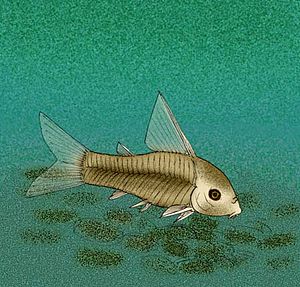Corydoras revelatus facts for kids
Quick facts for kids Corydoras revelatus |
|
|---|---|
 |
|
| Artist's reconstruction | |
| Scientific classification | |
| Kingdom: | |
| Phylum: | |
| Class: | |
| Order: | |
| Family: |
Callichthyidae
|
| Subfamily: |
Corydoradinae
|
| Tribe: |
Corydoradini
|
| Genus: |
Corydoras
|
| Species: |
C. revelatus
|
| Binomial name | |
| Corydoras revelatus Cockerell, 1925
|
|
Corydoras revelatus was an ancient type of catfish that lived millions of years ago. It is now extinct, meaning it no longer exists. Scientists know about this fish from a single fossil found in Argentina.
This fossil was discovered in rocks that are about 58 to 58.5 million years old. This time period is called the Late Paleocene epoch. Finding such an old fossil helps us learn about fish that lived long before humans existed.
Contents
Discovering an Ancient Fish
The only known fossil of Corydoras revelatus was found in a place called Salta, Argentina. It was found in a rock layer known as the Mais Gordo Formation. Scientists use special methods to figure out how old these rocks are. This helps them know when the fish lived.
The fossil was first described by a scientist named Cockerell in 1925. This discovery gave us a peek into the distant past of fish.
What Did Corydoras revelatus Look Like?
From the fossil, scientists can tell that Corydoras revelatus had a unique look. Its head was shorter and more rounded compared to the catfish we see today. It also had eyes that were set quite low on its head.
Even though we only have one fossil, it gives us clues about what this ancient fish was like. It helps us imagine how it swam and lived in the ancient waters.
Why Is This Fossil Important?
Corydoras revelatus is a member of a group of fish called callichthyid catfish. Even though its exact spot in the Corydoras family tree is still being studied, its fossil is very important. It confirms that these types of catfish were already starting to develop into different kinds of species a very long time ago.
This fossil shows that the callichthyid fish family was already changing and growing before the Paleocene period ended. It helps scientists understand how different fish species evolved over millions of years.
See also
 In Spanish: Corydoras revelatus para niños
In Spanish: Corydoras revelatus para niños

